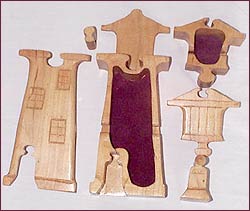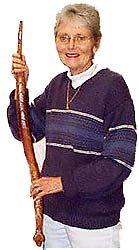
Her wooden snakes wriggle like the real thing, right up until their linchpin eye is removed. Then, from head to tail, they slip apart into a table full of cleverly interlocking puzzle pieces. Dolphins, alligators, elephants, seahorses, turtles and bears flex their wooden muscles the same way in a puzzled circus of undulating wood, all crafted by a sprightly elf of a woman who puts Pinocchio puppetmaster Geppeto to shame.
Crackling with joyous energy, with a grin on her face and a chuckle not far behind, Carol Zandell seems far younger than her sixty-six years. A retired high school teacher, she spends her time turning, carving, and designing a dizzying array of puzzle boxes, lumberjacks, whirligigs, dolls, yo-yos, tops, and gaily colored spinning, moving, and otherwise animated wood. In short, she makes toys.
“The things I do are fun and quick, and don’t really require all that much expertise. I like the old-time toys the best, like merry-go-rounds on strings, spinning tops, yo-yos, moving pull toys, and balancing toys, because of their simplicity,” Carol explained. “Kids of all ages still enjoy playing with them, and there is no greater pleasure than seeing a smile light up the face of a youngster with a new ‘old toy,’ or oldsters remembering that toy from their past.”
Some have crank mechanisms, where you twist a crank and the person or animal on the box moves, jumps, or dances. Others, like the old style merry-go-rounds, hang from strings like a miniature May pole. They wind and unwind themselves tirelessly, spinning as they go. Pull toys waddle, pop, and flap as they follow behind, and puzzles and boxes challenge you to unhinge their secrets.
It’s quite obvious that for Zandell, woodworking is all about fun. “If my hobbies are not fun, I don’t want to do them. Toys fit that philosophy to a “T”. Watching them go from a chunk of wood to a box, animal, or toy is what makes it worthwhile.” Her love of wooden toys started early. “I grew up around woodworking,” she told me. “My dad always built us toys, and always let us participate in making them.”
About 12 years ago, a friend introduced her to carving in the round. While she still does lots of that, her favorite style is “hobo art” carving; chunks of wood whittled into flexible chains, balls in cages, rings inside of rings, and successions of rotating balls inside of balls inside of balls. “My favorite carvings are the complex ball and chain hobo carvings. I think the first time I saw hobo carving was when I was spending some quality time in the principal’s office as a student,” she admitted, chuckling. “He whittled chains and pliers from wood, and had them adorning his office.”

Decades passed before she learned how to do it herself. “At a carving show in Monroe [Washington], there were two old guys who had a whole display table of hobo art carving. I was hooked, and decided I wanted to do that.” She taught herself how using books from the library, but carving soon expanded into a greater variety of items.
“It was kind of a progression. I started carving, so I needed to cut out carving blanks. I soon got very comfortable using the band saw. One day, at a meeting of a carver’s club, someone came in with a band saw box. I started making band saw boxes, which evolved into puzzle boxes made on the band saw, and eventually puzzle animals. The first ones were from patterns I found in magazines, then I started to make up my own patterns.”
A lot of the fun for her is figuring out how to make interlocking puzzle boxes, some of which have hidden ball bearing catches or magnets. “The ones with magnets are called knock boxes. Inside, there is a pin. When you turn the box upside down, the pin slides onto a magnet, locking the box. To disengage it, you must bang the bottom of the box on a table, which knocks the pin loose from the magnet, and allows the box to open. Obviously, you don’t use magnets a that are too strong.”
As she progressed, her puzzle boxes became more elaborate. “This one has a labyrinth hidden inside the box. You must twist and turn the box so that a ball bearing and sliding dowels move. If you twist and turn in the right sequence, the box opens.”
She doesn’t sell her toys. Some go to her one grandchild, or other family members, but most go to a variety of charities. “Once in a blue moon, I will make something and sell it, but I sure don’t build to sell anymore.” She learned her lesson the hard way. “One time, I took some puzzle boxes to show a friend, and some of her friends asked me to make a few for them.” Before she knew it, she was taking orders. “Boy, was that a mistake. It became a job instead of fun, but I had to get them done, because I had promised them.” She estimates that she sold a couple of hundred boxes before she came to her senses.

Not surprisingly, many of her carvings and turnings have won ribbons at various competitions, usually in the advanced category. “I do that to support the clubs I belong to rather than for myself. It helps the club financially by getting pieces into the carving shows and fairs, especially with juried shows.” When I asked her how many blue ribbons she has won, she replied “I have no idea. I haven’t counted them. I just stuff them all in cardboard boxes.” Apparently, there are quite a few.
Locally, she lectures and demonstrates to many of the carving, woodturning, and woodworking clubs, as well as demonstrating at area woodworking stores. Though she won’t pass out copyrighted patterns from magazines, Carol is very free with her own designs. She shares all her patterns with her students, and will often email them to friends who ask.
But mostly, she says, it is all about fun, both for herself, and for those with whom she shares her knowledge. “I like to spark that interest in others so that they will go out and do something fun as well. They may not do exactly what I do, but at least I will have inspired them to enjoy themselves.”





